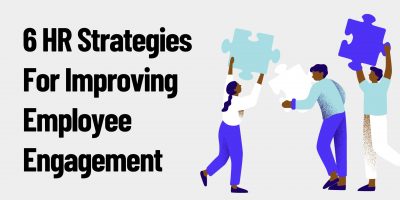
6 HR Strategies For Improving Employee Engagement
Transform your workplace with HR strategies designed to boost employee engagement, drive productivity and job satisfaction, and foster a culture of growth and success.

Recognition doesn’t have to be expensive to be meaningful.
Employee rewards statistics show that 65% of workers preferred non-cash incentives and that a simple expression of gratitude from someone in charge resulted in 50% higher productivity.
While financial rewards are certainly motivating, simple, genuine gestures that make workers feel seen and appreciated can be just as impactful.
Below, we explore how to reward employees without money and how this zero-budget recognition impacts organizational success.



Recognition becomes a powerful tool at the hands of employers who know how to use it.
For example, according to Harvard Business Review, even a little appreciation can lead to a big moral boost among the workforce.
Retention statistics also show that 71% of employees would be less likely to leave their employer when recognized more frequently.
While cash rewards are often the first thing that comes to mind, not every company has the budget for them—and, as it turns out, they’re not always the best choice.
A study by Gallup researching low-cost-high-impact recognition shows that six methods were most memorable to employees, and five of them are (or can be) non-monetary:
Gallup’s data also reveals that the most effective recognition is sincere, personalized, and tailored to each employee’s preferences.
The value of non-monetary incentives is not always measured in quantifiable terms but in how they make people feel. Simple gestures like a thank-you note can be incredibly valuable if they are significant to the individual and come from the right person.
Therefore, creating a successful employee recognition plan doesn’t have to be excessive or expensive but requires a solid strategy that moves away from the one-size-fits-all approach.
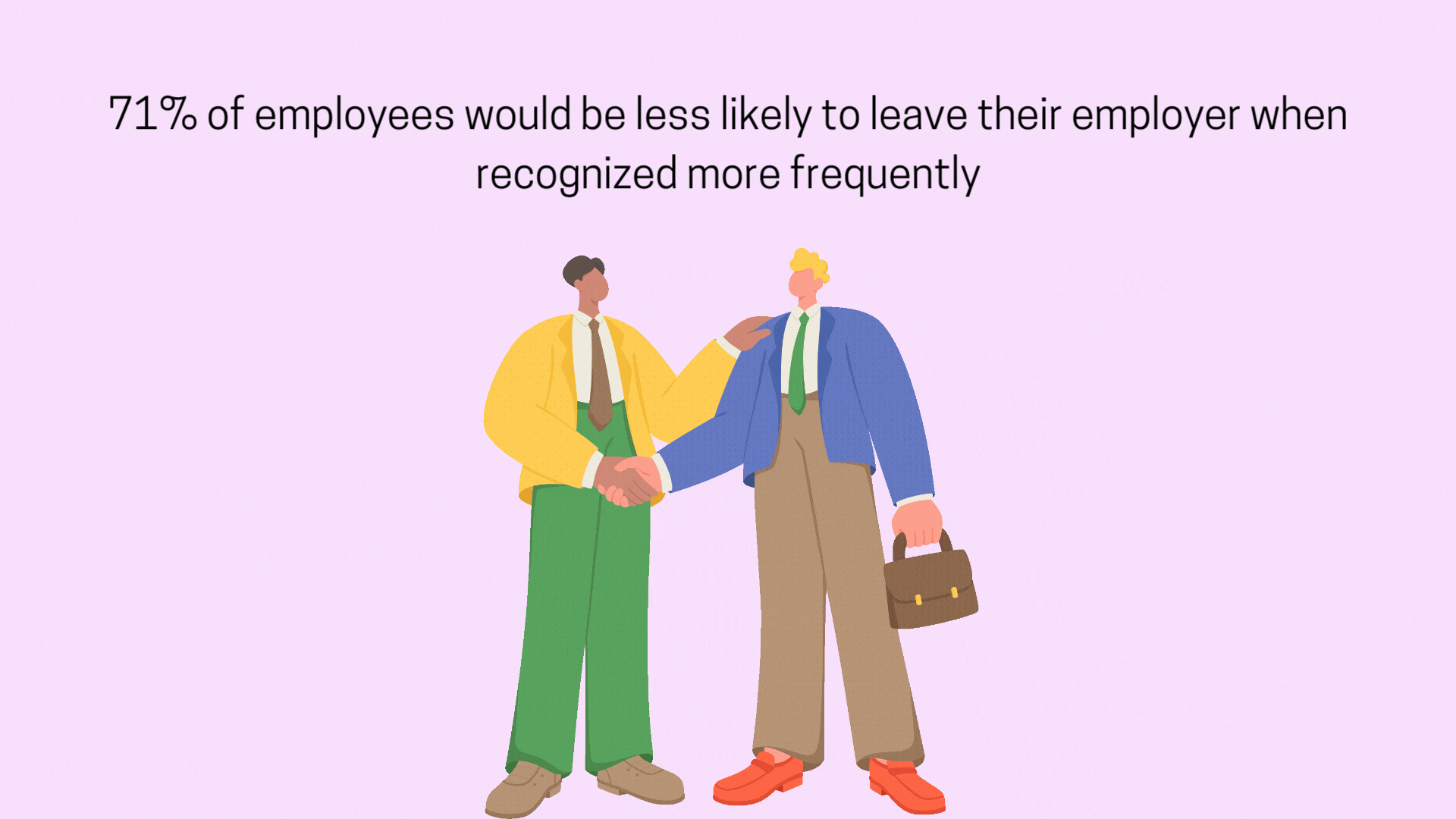
When employees get recognized for their effort, creativity, or teamwork, it fuels a sense of pride and motivates them to keep pushing forward.
Non-monetary incentives can be a regular, even daily, reminder that their contributions matter, creating a ripple effect of productivity throughout the organization.
Now the question is, how to reward employees without money and make it meaningful?
Several strategies emerge, from verbal and written recognition to higher autonomy and growth opportunities.
Verbal recognition involves acknowledging an employee’s efforts, achievements, or contributions through spoken praise.
It’s personal, direct, and often informal.
It also seems to be the most preferred option for day-to-day accomplishments.
An analysis by Deloitte on employee recognition strategies shows that 54% of workers preferred a verbal “thank you,” 31% chose written recognition, and only 7% wanted a gift or a celebration.
Whether in a one-on-one or group setting, offering verbal recognition is an excellent and cost-free way to show appreciation for employees and reward their performance.
While verbal recognition tends to have more impact on a day-to-day basis, written recognition still holds significant value for many employees.
It’s a formalized way of acknowledging individual or team effort through emails, company communications, performance reviews, recognition letters, certificates, or other written forms.
This tangible record of accomplishments adds meaning to one’s success and is a lasting reminder or recognition that an employee can revisit.
According to Deloitte’s analysis from earlier, cash isn’t the preferred recognition choice, even when the accomplishment is significant.
The most valued employee recognition strategy across organizational levels, generations, and genders is a new growth opportunity.
In fact, 47% of employees chose this over a salary increase (23%), and the percentage was higher for Millennials (51%).
These professional growth opportunities help workers develop their careers and expand skills in the long term, hence their preference.
Examples include access to training programs, workshops, conferences, certifications, or seminars that enhance workers’ knowledge and abilities. Internal mentorship programs are another zero-budget initiative that can strengthen skill development.
Offering such opportunities signals to employees that their employer values their growth and is invested in their success while giving them the tools and support needed to advance their careers.
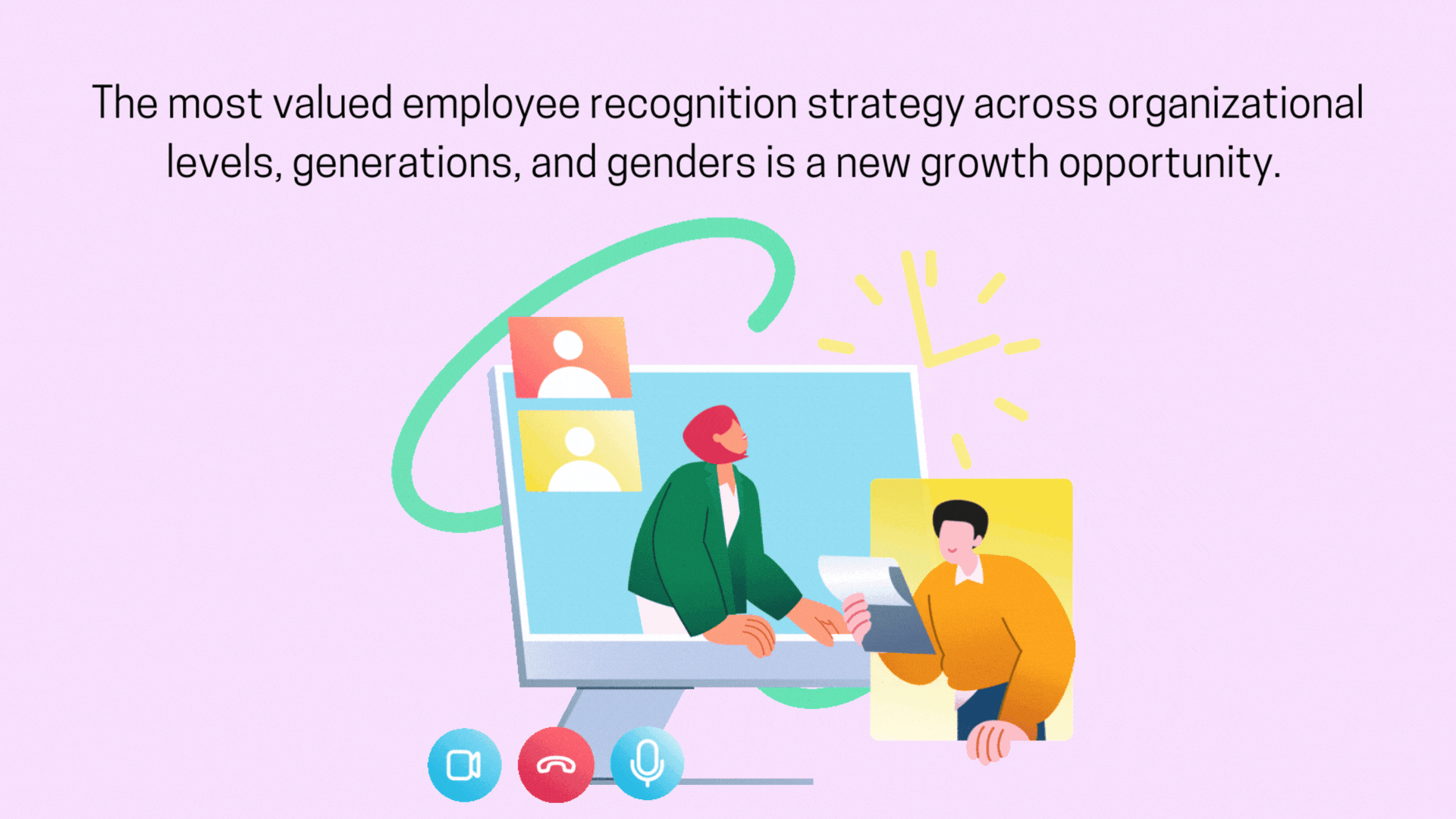
Visibility and exposure are great ways to reward employees without spending money.
Acknowledging achievements in team meetings, company-wide emails, work events, or on social media makes employees feel valued and encourages others to perform well.
However, when it comes to social recognition, Deloitte’s analysis found that employees generally prefer public recognition when limited to a small group. Private recognition was the second most preferred, while broad public recognition was the least favored.
Therefore, before using visibility and exposure as an incentive, it’s a good idea to have a conversation with employees to understand their preferences for how and where they’d like to be recognized.
Findings from Envoy’s Return to Workplace report emphasize that flexibility is the “new” benefit for employees.
Flexibility in choosing workdays and hours was considered as important as traditional benefits like PTO and 401(k) matching, as 63% of workers feel more empowered when they have flexible work options.
So, what better way of acknowledging employees than to reward them with something they genuinely care about?
The study also indicates that allowing workers to customize their schedules, locations, or other working conditions to fit their needs and preferences can increase job satisfaction and reduce stress, as employees feel more in control of their time and responsibilities.
A University of Birmingham Business School study shows that autonomy positively affects well-being and job satisfaction.
Workplace autonomy describes the degree of independence employees have in how they approach their work. It allows them to make decisions, set priorities, and determine how to complete tasks without micromanagement.
For example, employers can offer greater control over task execution and project ownership, allow remote or hybrid work options, enable self-directed learning, and support employees’ decision-making authority.
When done right, these practices lead to positive outcomes without the need for financial incentives.

There is more to employees than their work.
Behind swift task completion and stellar performance, a foundation of personal contribution and social engagement strengthens workplace culture. Recognizing individuals for who they are, not only what they do, ensures they feel valued for all their contributions.
Finally, something as simple as a private workspace or a designated parking spot can show appreciation for a job well done on a zero-budget strategy.
Office privileges can improve the work experience, making the workplace more comfortable and convenient by offering employees greater flexibility and control over their environment.
This creates a more personalized space where they feel valued and can work in ways that suit their preferences.
Regardless of the strategy, whether it’s a new growth opportunity or introducing flexible benefits, knowing how to do it right will, eventually, shape the outcome.
It’s not just about meaningless gestures or quick fixes; it’s about establishing thoughtful, effective practices that drive long-term success.
Consequently, the following is a staple for any successful recognition program:
O.C. Tanner’s report on integrated recognition reveals that, when done right, recognition leads to great work (+1,181%), higher engagement (+784%), and a thriving work culture (+648%).
At the same time, the correct methods can lower employee attrition (-29%) and burnout (-80%).
Just as the right approach can leave a good impression, deficient recognition experiences don’t fade away quickly, reveals O.C. Tanner’s report.
Employees who had negative experiences in previous jobs were more likely to report issues in their current roles, including:
From there, it’s easy to assume that the most common pitfalls with recognition, both monetary and non-monetary, occur when companies see recognition solely for their benefit.
It makes incentives feel forced and insincere and can have the opposite effect.
Other issues may include infrequency, as recognition given too rarely leads to disengagement, and vague criteria, which could cause confusion and resentment among workers who don’t understand what and whose behaviors are being acknowledged.
These common pitfalls often result from not aligning a strategy with the key practices mentioned earlier, which are crucial for creating a positive work environment and ensuring the program’s success.
To measure the success of a zero-budget employee recognition program, employers can focus on key indicators that highlight its influence, including employee satisfaction and engagement, return on investment, productivity and retention, etc.
From there, the following questions emerge:
How satisfied are employees with the recognition they receive?
Companies can gather feedback through surveys, one-on-one discussions, or by tracking engagement with recognition programs. Employee satisfaction indicates a successful program, but it can also point out areas of improvement.
How effective is the program?
Measuring the effectiveness of incentives, monetary or non-monetary, involves examining different organizational metrics, such as employee performance, engagement, retention, or cost savings. Any long-term improvements in these areas signify that the program is on track.
What’s the ROI?
Since we’re talking about zero-budge recognition or very cost-effective incentives, any improvement in the metrics shows a return on investment—however, their extent hints at the effectiveness of the initiatives.
Is recognition contributing to a positive company culture?
Observe the tone of workplace interactions, team collaboration, and overall employee morale. A shift toward a more collaborative, supportive environment suggests that recognition fosters a positive and inclusive culture.

Non-monetary incentives can be a great way to motivate and recognize employees, but they have their challenges.
Without personalization, they can fall flat, and some employees might feel they’re not being valued enough compared to those receiving monetary rewards.
However, when done right, non-monetary rewards can complement financial incentives and create a more holistic recognition system.
The key is striking a balance between the two, tailoring rewards to individual needs, and understanding how to reward employees without money effectively.
Disclosure: Some of the products featured in this blog post may come from our partners who compensate us. This might influence the selection of products we feature and their placement and presentation on the page. However, it does not impact our evaluations; our opinions are our own. The information provided in this post is for general informational purposes only.
Content Writer at Shortlister
Browse our curated list of vendors to find the best solution for your needs.
Subscribe to our newsletter for the latest trends, expert tips, and workplace insights!

Transform your workplace with HR strategies designed to boost employee engagement, drive productivity and job satisfaction, and foster a culture of growth and success.

Explore free LMS solutions for practical corporate training and professional talent development.
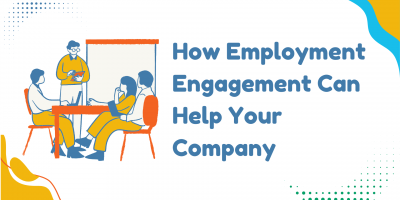
Discover how effective employee engagement drives productivity, retention, and profitability. Learn proven strategies to build a happier, more engaged workforce.
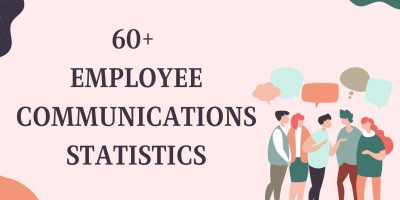
Empower your workplace with these vital statistics to enhance engagement, collaboration, and productivity.
Used by most of the top employee benefits consultants in the US, Shortlister is where you can find, research and select HR and benefits vendors for your clients.
Shortlister helps you reach your ideal prospects. Claim your free account to control your message and receive employer, consultant and health plan leads.